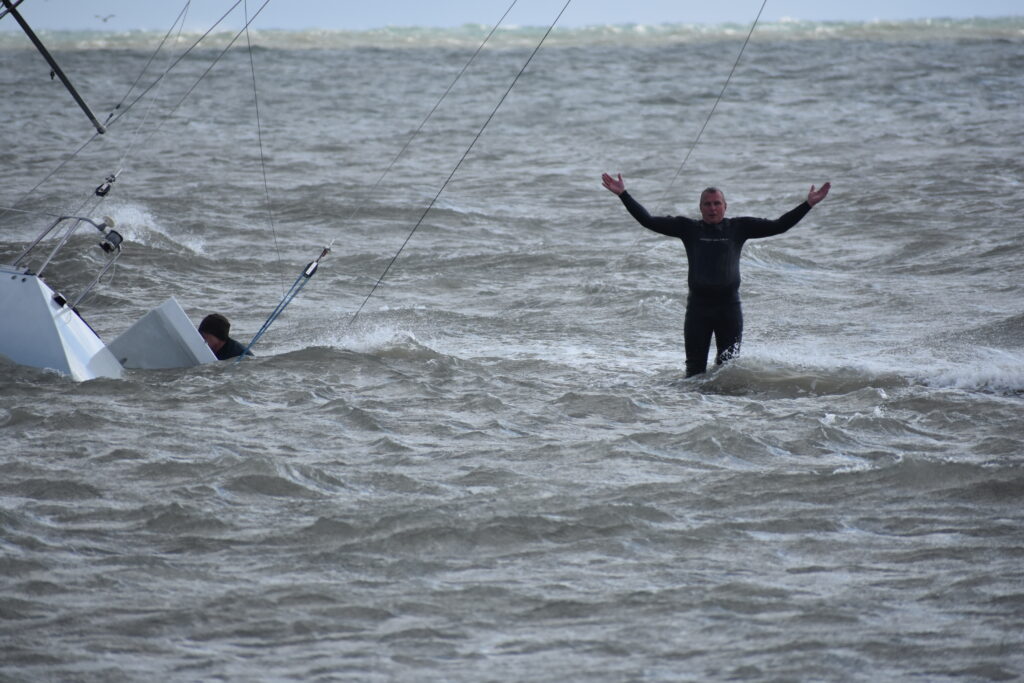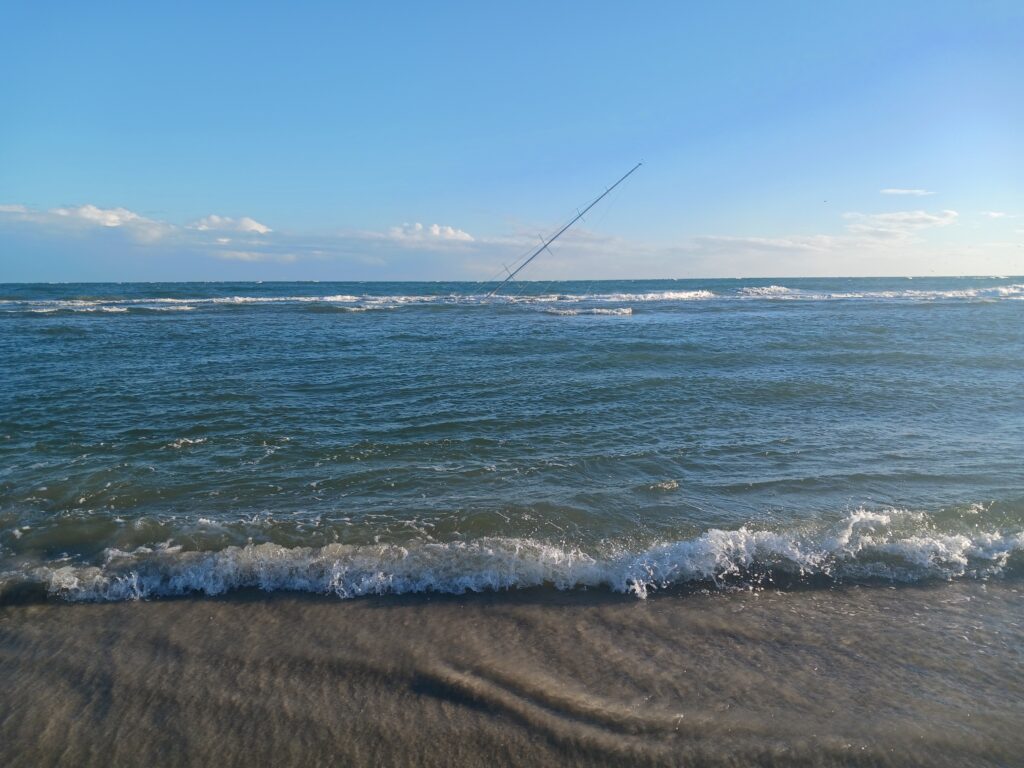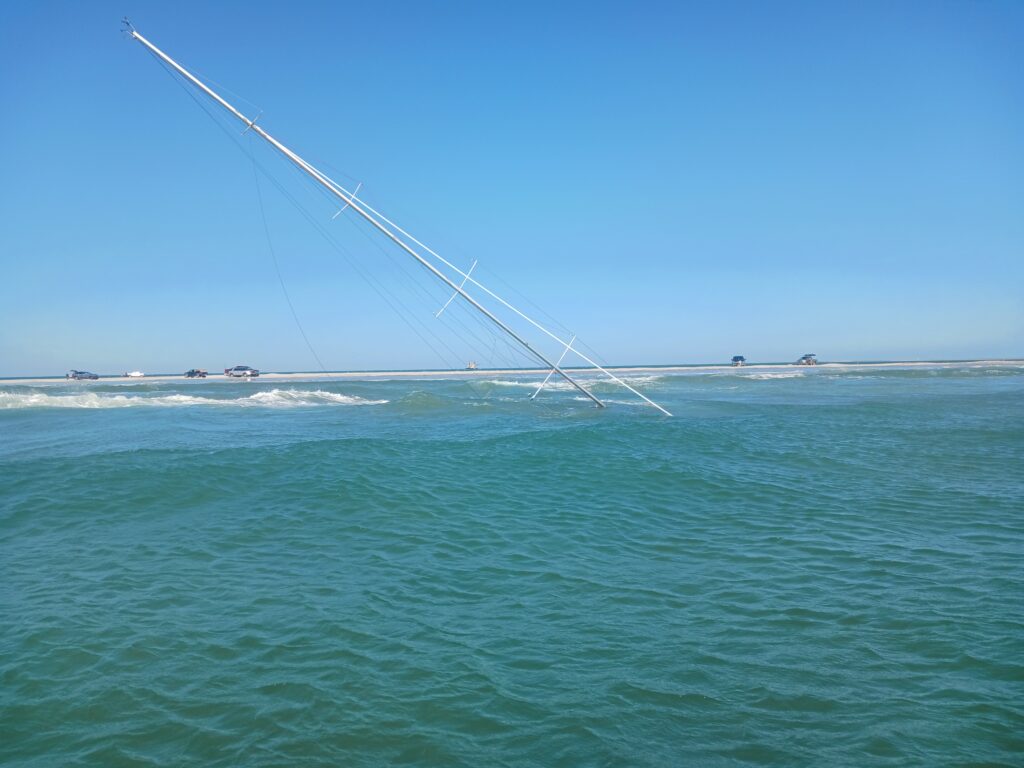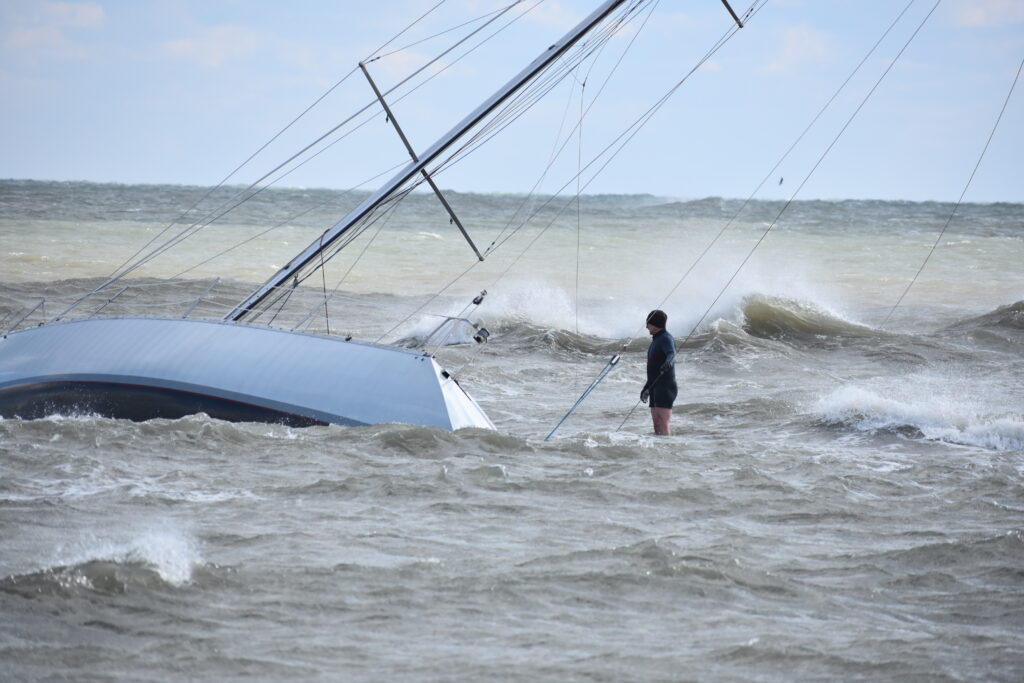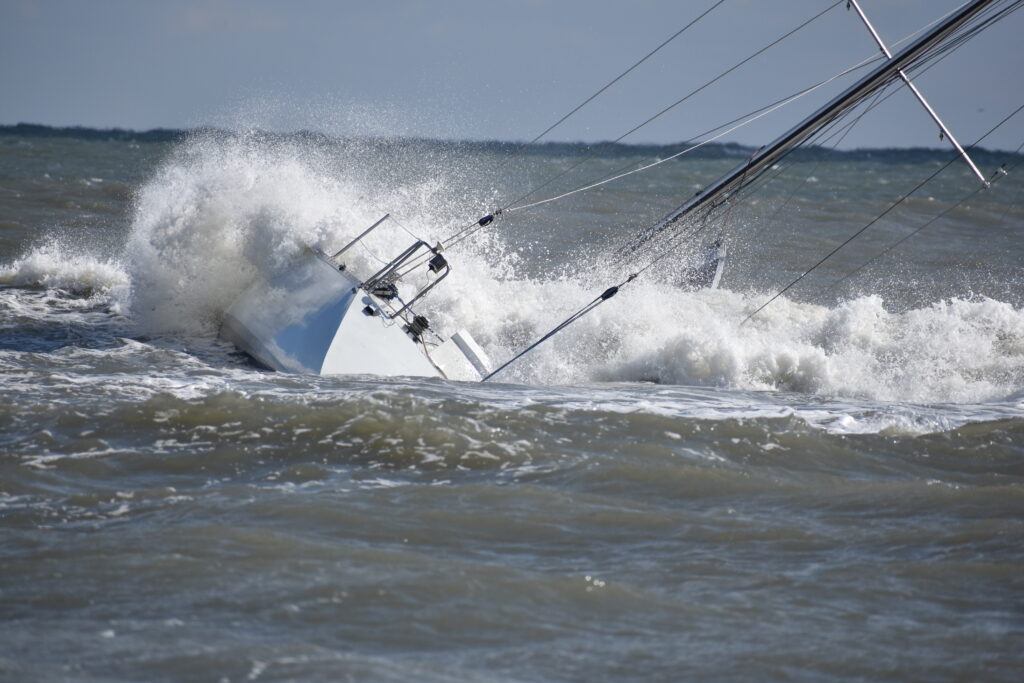The First Shipwreck of 2023
Each year, the tough weather conditions and shifting shoals of the Outer Banks claim several victims, especially in fall, winter, and early spring. This season, the shipwrecks begin with the 51′ Wasa Racing Sloop grounded near the inlet beach of Ocracoke in the wee hours of the morning on November-2. The vessel was motoring southbound to Florida on the oceanside of the Cape Hatteras and Ocracoke when they ran aground near Ocracoke Inlet after experiencing electrical and mechanical failures aboard. The crew survived with no injuries, but the vessel is quickly becoming a total loss. It took less than 24-hours for the boat to become fully covered in sand and totally under the water. Salvage attempts were abandoned when the weather became tougher than originally forecasted. Now, only the beautiful mast and spreaders can be seen sticking just above the waves as if this happened weeks or months ago. Unfortunately, the situation that led to this wreck is not unique and seems to repeat itself every year because of the geography of Cape Hatteras, Cape Lookout, and Cape Fear. The three capes rub very closely with the strong and warm northward flowing Gulf Stream, the lesser Labrador Current, and the resulting eddies that spin off of both. Many seem to underestimate the strength of the wind and the state of the sea, and the result is often a near miss or a complete catastrophe.
The Vessel
The grounded 1983 WASA Atlantic 51 Sloop is a nicely appointed sailing sloop. It is a high performance racer-cruiser built in Sweden with a 7’ draft. The mast boasts 3 spreaders topped with a jumper strut set of spreaders near the top. While sailing, this rod rigging supported mast is additionally supported by running backstays which appear to be check stays intended to keep the center of the mast from bowing forward as the boat pounds into waves. Some compare the hull shape to that of a Santa Cruz 50 but built with heavier fiberglass composites.
Causes of the Wreck
Shipwrecks normally result from a series of unfortunate errors and equipment failures compounded by darkness, cold, high winds, and breaking waves, and this wreck is no exception. A cold front with high winds and squalls was passing through the area that night. Ultimately, the cause of this wreck is a snowball of mishaps. Boat parts and equipment are most stressed in bad weather and high sea states so they tend to fail when you need them most. The owner and primary captain reports a failed alternator which caused battery failure and the resulting loss of electrical systems and navigation tools. As a result, at the time of the grounding, the captain was down below attempting to troubleshoot electrical failures when the watch crew navigated off course into Ocracoke inlet, close to the beach, and hard aground.
Weather, Sea Conditions, and Equipment Failure
The weather on the night of the accident was really bad, but typical for the Outer Banks during the fall, winter, and spring. The pattern is well established and well predicted. Rapidly passing cold fronts regularly push through the area and become amplified by the warm Gulf Stream. These fronts can come through as frequently as twice per week in the winter. The cycle begins with increasing Southerly winds that start clocking as the front approaches. The wave heights quickly become large not far offshore. Just at the peak of the southerly pattern, the winds take an abrupt North, NW turn and blow hard for days sending big swells to Puerto Rico and Northern Caribbean. Northerly gales blowing against the Gulf Stream current make for extremely hazardous sea states. Sustained winds from 30 to 70 knots are not uncommon on a regular basis.
This unnerves less experienced skippers, instinct kicks in, and the common tactical error is made when boats head inshore to find refuge in the Sound. Unfortunately, the Oregon, Hatteras, and Ocracoke Inlets are not friendly under the best of conditions and are difficult to the most experienced local mariners. The inlet waters are shallow and the charts cannot keep up with shifting sand bars and transient channels. Each of these inlets have regular dredging year round just to keep them navigable for ferry service and local fishermen.
Crew Experience
Experienced mariners know not to attempt rounding the Capes in Winter. This particular crew underestimated the conditions significantly. Worse yet, the reported float plan was to motor around the Capes heading Southbound. They did not intend to use the sails, and confirmed they were motoring with sails down when the problems began. A sloop without a sail up in rough seas is not a pleasant experience and the pounding is hard on the equipment. In even the smallest swell, a keelboat rides much better with side pressure in the sails to to decrease rolling. In nearly critical gulfstream conditions, a sloop without the sails up will be rocking and rolling, pitching drastically. The unstable pitching has a trickle down effect on the systems aboard the vessel – stirring up sediment in the diesel tanks, clogging fuel filters, tossing gear around the cabin – eventually the crew become disenchanted and fatigued which compounds all the problems aboard. A skipper must be able to sail a sailboat when cruising offshore. The engine is an auxiliary system designed as a backup or an augmentation. The decision to motor with sails down was the first of several tactically bad decisions, the worst of which was to head inshore near the capes and attempt the inlet at night.
Maybe in some locations it makes sense to get closer to land when the going gets rough, but that strategy is not good near the 3 North Carolina Capes. Storms passing make breaking wave conditions in the inlets, and the Capes are riddled with shoals and sandbars near shore and farther from shore. Most of these shoals and sandbars are shifting and not charted well. In this case, the crew lost the chartplotter after losing the power supply at night in challenging conditions. It was a critical failure. Without solid experience and quick reflexes in wise courses of action, it can be just a matter of minutes before a vessel finds itself aground. In storm conditions with waves over 6 – 10 feet the shallow spots will have large breaking waves. Boats sometimes can opt to put out very long anchor tackle, but it can fail too under such strong forces. With the right anchor line and ground tackle, this strategy can work but you have to prepare in advance and still need local knowledge of the shoals off the beach. We often see shrimp boats spending the night on anchor just off the beach, but these commercial watermen know where to position themselves safely, and they are equipped to stay on anchor in rough conditions. In this case, the crew were underway approaching the inlet at night with power failures on board and no sails set.
Salvage Efforts
The vessel grounded near the beach at the South tip of Ocracoke between midnight and 2am on November 2 and the Sheriff’s Office assisted the crew safely off the boat. It landed close enough to shore that the crew was able to walk ashore albeit through strong current and wave action. Word of the wreck was spread to various marine professionals in the area to help with the salvage, including my company Phillips Boatworks.
Insurance and Red Tape
Immediate recovery is best if possible, but hardly ever happens. There are many moving parts that have to be managed and need to all fall into place. The goal in this case was to find a way to save the vessel from breaking up in the surf, but the longer the boat sits the worse the situation becomes. Work cannot begin without money, permits, men, and equipment. Scarcity is an issue on the Outer Banks and even more so in Ocracoke. The island communities are small. Manpower and heavy equipment do not sit idle, particularly in winter when the vacationers have gone home and repairs and infrastructure projects are underway. The boat owner needs to elect a primary salvage manager quickly. Nothing can begin till that decision is made because money must be transferred. Men and resources have to be shifted. There are limited salvage resources locally, but other resources have to be brought in from hours away. In this case, because the boat was grounded near Ocracoke, everything needed to come over by ferry or by boat. The ferry ride is more than one hour and this time of year the schedule of ferries is reduced and subject to weather delay.
Time Is The Enemy Of Recovery
On Thursday morning November 2nd, I was the first salvage contractor on the scene. At that time, the weather models indicated calm conditions for the next several days and that stirred hope that the vessel could be rescued and towed away for repairs. On this, the owner contracted my company, Phillips Boatworks, to begin salvage efforts hoping that we could handle the sailboat and rigging with the least damage possible. Tragically, there were problems with the insurance policy and the claim was immediately denied leaving the cost of recovery to be financed entirely by the owner. When this happens, my company and most salvage contractors can only engage when funds are paid in advance with more held in escrow. This meant further delays before the work could begin. The owner wired a deposit mid-afternoon on Nov-2, but it was already too late in the day to gather resources onto the ferry to board the boat before sunset so that critical first day was lost.
Sadly, the weather and ocean keep churning. A safe and effective salvage requires a weather window. In this case, the vessel landed in a very bad spot in the inlet. Because of high current and seaside wave action every delay was a serious problem. When my team arrived on the scene Friday morning with the first tranche of equipment, the wind was blowing upwards of 20 knots and the current was ripping through over the boat at about 5 knots. It was high tide. Sand had already filled most of the interior of the boat, and we estimated that not even a large 4” trash pump could keep up with how fast the water and sand were coming in. We set up transfer lines and prepared to try again to seal the boat, evaluate the damage, and set pumps at low tide that afternoon. Tragically, by low tide the boat was totally under the sand and fully underwater. I was able to go on board into the cockpit, and stick just my head into the cabin at low tide. In the process, I was fighting 3-5 knots of current sweeping over the deck under breaking waves. We determined with the financial, weather, and time constraints, that constructive recovery efforts were no longer possible.
It is amazing how fast the sea can take a large vessel. Any beach goer who has stepped into the ocean with the current ripping sideways has noticed what happens to the sand in the current around your feet. A hole is dredged around the upcurrent side quickly and then the pedestal of sand your weight was holding down quickly collapses. The same thing happens with a heavy boat sitting in the strong current and shallow water. This process repeats itself until the seabed gets back to its equilibrium, which means the heavy object is now under the sand. This happened very fast in this case which was amplified by higher than expected sideshore winds. Less than 24 hours had passed since the boat ran aground.
From Salvage to Clearing
Strategies for saving the vessel now seemed unlikely, even the local Crane service would have issues getting its 95,000 lb crane 2 miles across the beach. At this point, the boat could possibly be broken apart and the debris removed, but given the depth of the wreck, distance from shore, depth of the water approach, the strength of the current, and the serious wave action at this particular location even breaking up the wreck has significant challenges.
The Blessing of a Safe and Uninjured Crew
No one was injured or killed during the loss of the vessel or salvage attempts. The owner is hopeful that he can resurrect his dream of sailing Cuba and the Caribbean with his wife and kids, and he is realistic about the lessons learned. Mariners must give the North Carolina Capes their due respect. The Capes have claimed many ships and many more lives rightfully earning the moniker “Graveyard of the Atlantic”.
Constructive suggestions for mariners….
- When possible, take the Intercoastal especially in the Fall, Winter, and Early Spring
- Do not go short handed or with inexperienced crew. Each member needs to be competent to stand watch
- Make sure your vessel and equipment are up to the challenge of the potential sea state.
- Getting past the 3 impassable inlets takes a while, and the weather changes quickly
- It is about 300 miles from the Chesapeake to Beaufort NC and 400 miles to Southport. A typical sailing yacht averages 100-150 miles per day on a good day. Against the wind and waves sometimes 0 – 50 miles forward (VMG) per day.
- Cold Fronts and Gale conditions can pass as frequently as 2 times per week in the winter which makes it almost a sure bet that gale conditions will be encountered in a 2 – 5 day rounding.
- Beaufort is a much better inlet but still challenging at night or in bad weather and Cape Fear is still to be rounded.
- From November to April, going outside around the Capes is treacherous at best
Nevertheless, sailing is a wonderful adventure. It can be dangerous, but just like flying an airplane, proper training and well maintained equipment can mitigate the dangers and allow for good times and lifelong adventures on the seas. Safe seamanship requires good teachers, ongoing practice, and experience building. Start with small challenges and work your way into harder challenges gradually, not all at once. Time your passages in the right season. Err on the side of caution. Expect equipment failures. Plan contingencies. Stay calm and sail your sailboat.
The Author, Jay Phillips
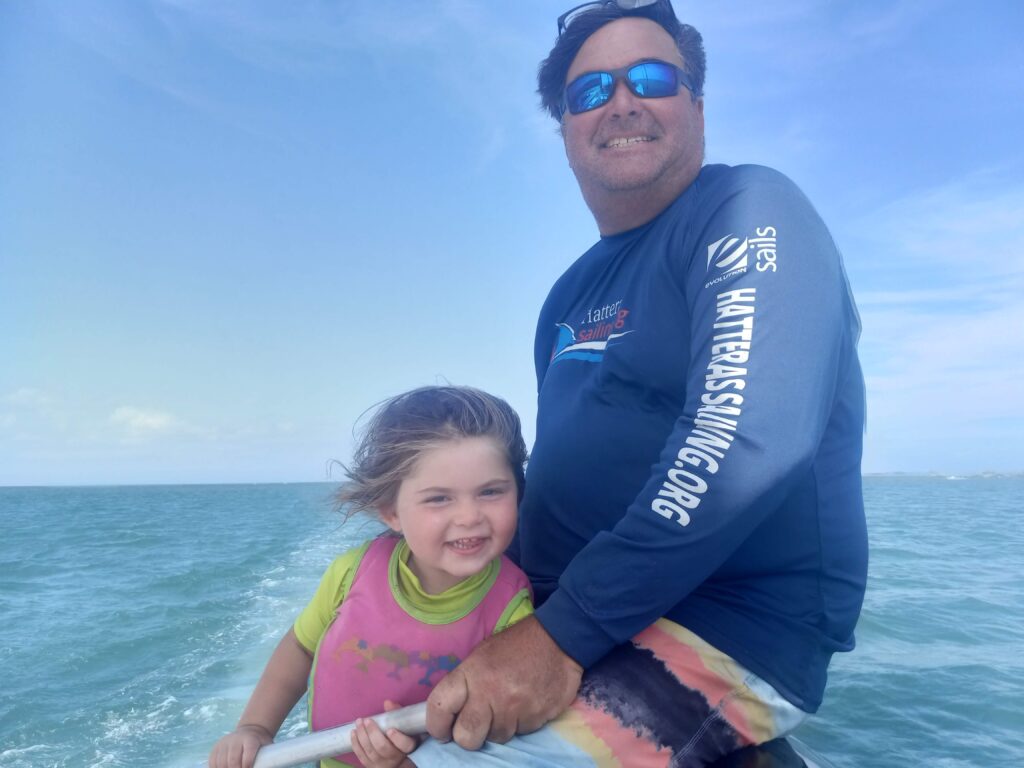
Sailing professionally since 1991, Phillips has roughly 100,000 or more blue water miles in sailing and motor vessels and has been teaching basic keelboat, racing and offshore passagemaking for 32 years. His company Phillips Boatworks offers charters, salvage services, sails and rigging, and boatbuilding out of the Hatteras Sailing Center in Buxton. Phillips was the developer of the Stiletto X Series Catamarans and now the Designer and Builder of the new pH-10 and pH-850 performance catamarans. If you are interested in learning safe passage making habits and skills, Jay and his wife Meg founded Hatteras Community Sailing (HCS) to further maritime education on Hatteras Island. Their passion is in training the next generation of sailors. HCS is a US SAILING recognized learning facility for all ages, and teaches all levels of racing and cruising education from Opti Kids and dinghy sailing to basic keelboat upwards through offshore passagemaking. For more information please visit phillipsboatworks.com and hatterassailing.org

